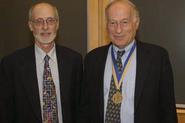
Martin Hirsch '60 gave a lecture titled "HIV/AIDS-Yesterday, Today, Tomorrow" for the Biology department during the Science Symposium held on Saturday, Oct. 1 and part of Hamilton's Science Center dedication weekend. Dr. Hirsch is a professor of medicine at Harvard Medical School, professor of infectious disease and immunology at Harvard School of Public Health and director of clinical AIDS research at Massachusetts General Hospital. Hirsch was introduced by Professor of Biology Ernest Williams, who presented him with a Hamilton Alumni Achievement Medal.
Hirsh began by giving an overview of HIV/AIDS. Currently, 38 million people are living with HIV, 2 million of whom are children. Doctors expect that between the years 2000 and 2020, 68 million people will die from AIDS.
HIV replicates in the body by attaching to cell surface receptors and being taken into the cell, where its viral RNA is released. The host cell's own processes and organelles translated the viral RNA into DNA, which is incorporated into the cell's own DNA. These genes are then transcribed into RNA which is translated into the proteins and genome for the next viral generation, and new virus cells are released from the now infected cell. Usually, cells act against virus cells in a few different ways. "Unfortunately, the [HIV] virus attacks the exact cell that is necessary for that response," explained Hirsch. The HIV virus attacks T-lymphocytes, which are integral for virus recognition and immune response. The average time from HIV infection to AIDS is eight to 10 years.
HIV was identified as the cause of AIDS in 1984. Between 1984 and 1986, many meetings were held with government representatives, researchers, pharmaceutical companies and constituency groups to decide on a plan of action. The result of these meetings was the formation of a national clinical trials network, called the AIDS Clinical Trial Groups (ACTG). Hirsch served as a leader of this group.
The first drug to show some promise was AZT. Within a few months of the trial beginning, there were 19 deaths in patients on the placebo and one death of a patient on AZT. However, the trial was cancelled as a result. The study showed that by giving patients a reduced daily value of AZT, the toxicity of the drug was not as strong, and treatment could be begun before advanced HIV set in, explained Hirsch.
Hirsch's research lab began testing Combination Antiretroviral Therapy, which used a combination of drugs instead of just one, which led to increased efficacy of the treatment. Between 1986 and 1990 certain drug combinations were found to work particularly well, and three combinations were tested in large controlled trials.
An important trial was known as ACTG 175, in which therapy with one drug was compared to therapy with a combination of drugs. The results were published in 1996 and showed that antiretroviral therapy improves the chances of survival for HIV patients and that treatment with two drugs slows HIV progress compared to one drug.
Currently, there are more than 20 drugs approved for treatment in the United States. "If you had asked me 20 years ago if this was possible, I would have said'no'," said Hirsch. The development of drugs has proven to kept patients alive much longer. However, "we aren't preventing it very well, which leads to more and more people being infected," explained Hirsch. While progress still stands to be made in prevention, an area where research has made great improvements is in transmission of HIV from mother to child.
There are still many issues to deal with. For example, the toxicities of the drugs create severe side effects, including cardiovascular risks. According to Hirsch, important issues to be working on now are to reduce the problems associated with current therapies and improve prevention efforts. "Most importantly, we must translate the progress made in the developed world into the developing world," said Hirsch. Ninety-five percent of HIV infections are in developing countries, where it is very difficult to receive treatment.
Very recently, there have been concerted efforts to begin anti-HIV drug treatment programs with appropriate monitoring in developing countries. Hirsch mentioned Thailand as an example of a country where anti-HIV treatment has greatly decreased the number of infected people. "The reason for improvement in Thailand is mostly commitment from top government leadership," said Hirsch.
Currently, the United States contributes approximately one-third of
the money used for treatments in the world; however, compared to other
countries, the official government assistance as a percentage of the
gross national income is one of the lowest. "The world still needs much
more commitment to this fight," said Hirsch in closing.
-- by Laura Trubiano '07
Posted October 3, 2005
